2023 HYUNDAI SANTA CRUZ navigation
[x] Cancel search: navigationPage 450 of 598
![HYUNDAI SANTA CRUZ 2023 Owners Manual Driver Assistance System
7-98
ONX4OB071072ONX4OB071072[1] : Driving route, [2] : Branch line,
[3] : Curved road section, [4] : Main road
• If there is no destination set on the
navigation, Highwa HYUNDAI SANTA CRUZ 2023 Owners Manual Driver Assistance System
7-98
ONX4OB071072ONX4OB071072[1] : Driving route, [2] : Branch line,
[3] : Curved road section, [4] : Main road
• If there is no destination set on the
navigation, Highwa](/manual-img/35/56179/w960_56179-449.png)
Driver Assistance System
7-98
ONX4OB071072ONX4OB071072[1] : Driving route, [2] : Branch line,
[3] : Curved road section, [4] : Main road
• If there is no destination set on the
navigation, Highway Auto Curve
Slowdown function will operate based
on the curve information on the main
road.
• Even if you depart from the main
road, Highway Auto Curve Slowdown
function may temporarily operate
due to navigation information of the
highway curve section.
WARNING
• Navigation-based Smart Cruise
Control is not a substitute for safe
driving practices, but a convenience
function. Always have your eyes on
the road, and it is the responsibility
of the driver to avoid violating traffic
laws.
• The navigation’s speed limit
information may differ from the
actual speed limit information on the
road. It is the driver's responsibility
to check the speed limit on the
actual driving road or lane.
• Navigation-based Smart Cruise
Control will automatically be
cancelled when you leave the
highway main road. Always pay
attention to road and driving
conditions while driving.
• Navigation-based Smart Cruise
Control may not operate due to the
existence of leading vehicles and
the driving conditions of the vehicle.
Always pay attention to road and
driving conditions while driving.
• When you are towing a trailer or
another vehicle, we recommend
that Navigation-based Smart Cruise
Control is turned off due to safety
reasons.
Page 451 of 598
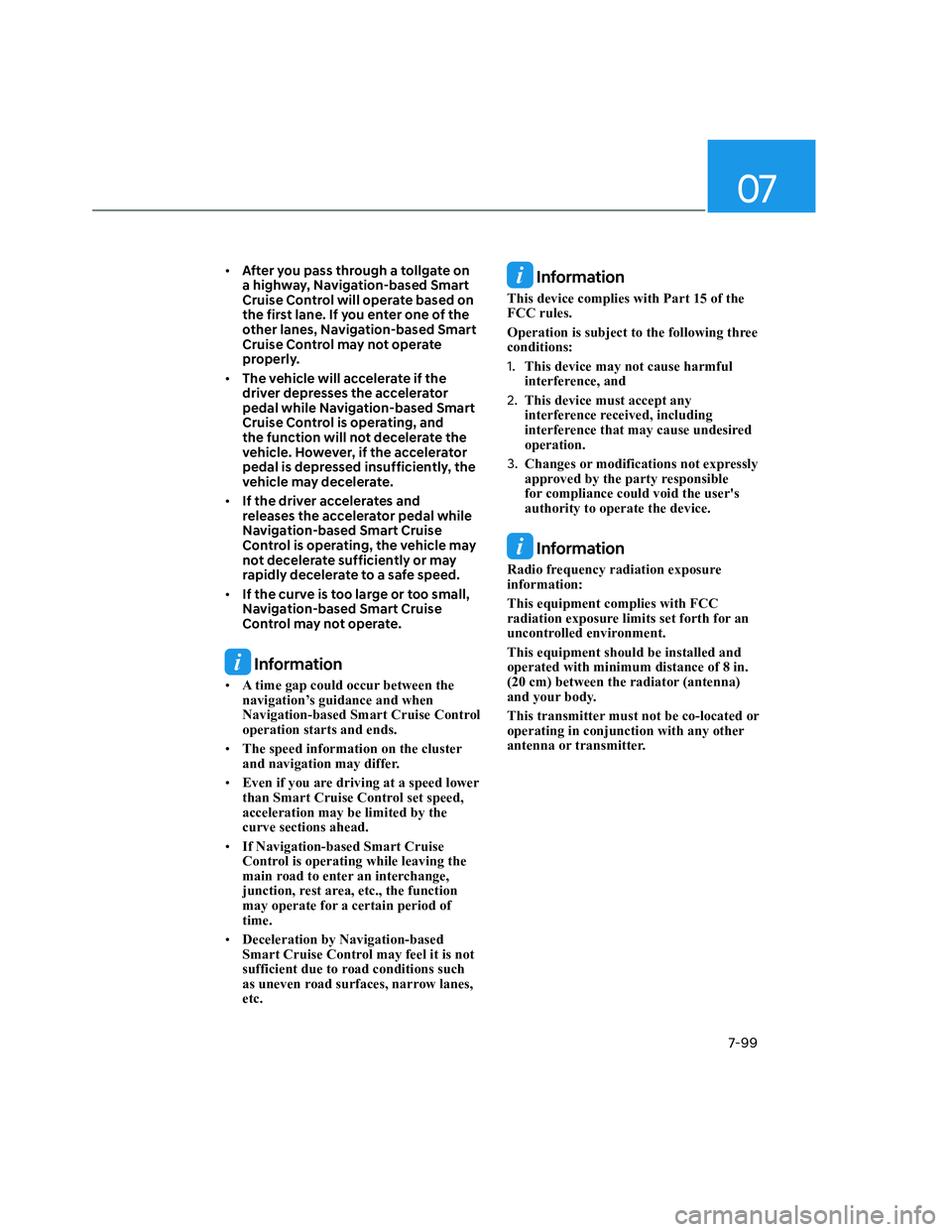
07
7-99
• After you pass through a tollgate on
a highway, Navigation-based Smart
Cruise Control will operate based on
the first lane. If you enter one of the
other lanes, Navigation-based Smart
Cruise Control may not operate
properly.
• The vehicle will accelerate if the
driver depresses the accelerator
pedal while Navigation-based Smart
Cruise Control is operating, and
the function will not decelerate the
vehicle. However, if the accelerator
pedal is depressed insufficiently, the
vehicle may decelerate.
• If the driver accelerates and
releases the accelerator pedal while
Navigation-based Smart Cruise
Control is operating, the vehicle may
not decelerate sufficiently or may
rapidly decelerate to a safe speed.
• If the curve is too large or too small,
Navigation-based Smart Cruise
Control may not operate.
Information
• A time gap could occur between the
navigation’s guidance and when
Navigation-based Smart Cruise Control
operation starts and ends.
• The speed information on the cluster
and navigation may differ.
• Even if you are driving at a speed lower
than Smart Cruise Control set speed,
acceleration may be limited by the
curve sections ahead.
• If Navigation-based Smart Cruise
Control is operating while leaving the
main road to enter an interchange,
junction, rest area, etc., the function
may operate for a certain period of
time.
• Deceleration by Navigation-based
Smart Cruise Control may feel it is not
sufficient due to road conditions such
as uneven road surfaces, narrow lanes,
etc.
Information
This device complies with Part 15 of the
FCC rules.
Operation is subject to the following three
conditions:
1. This device may not cause harmful
interference, and
2. This device must accept any
interference received, including
interference that may cause undesired
operation.
3. Changes or modifications not expressly
approved by the party responsible
for compliance could void the user's
authority to operate the device.
Information
Radio frequency radiation exposure
information:
This equipment complies with FCC
radiation exposure limits set forth for an
uncontrolled environment.
This equipment should be installed and
operated with minimum distance of 8 in.
(20 cm) between the radiator (antenna)
and your body.
This transmitter must not be co-located or
operating in conjunction with any other
antenna or transmitter.
Page 461 of 598
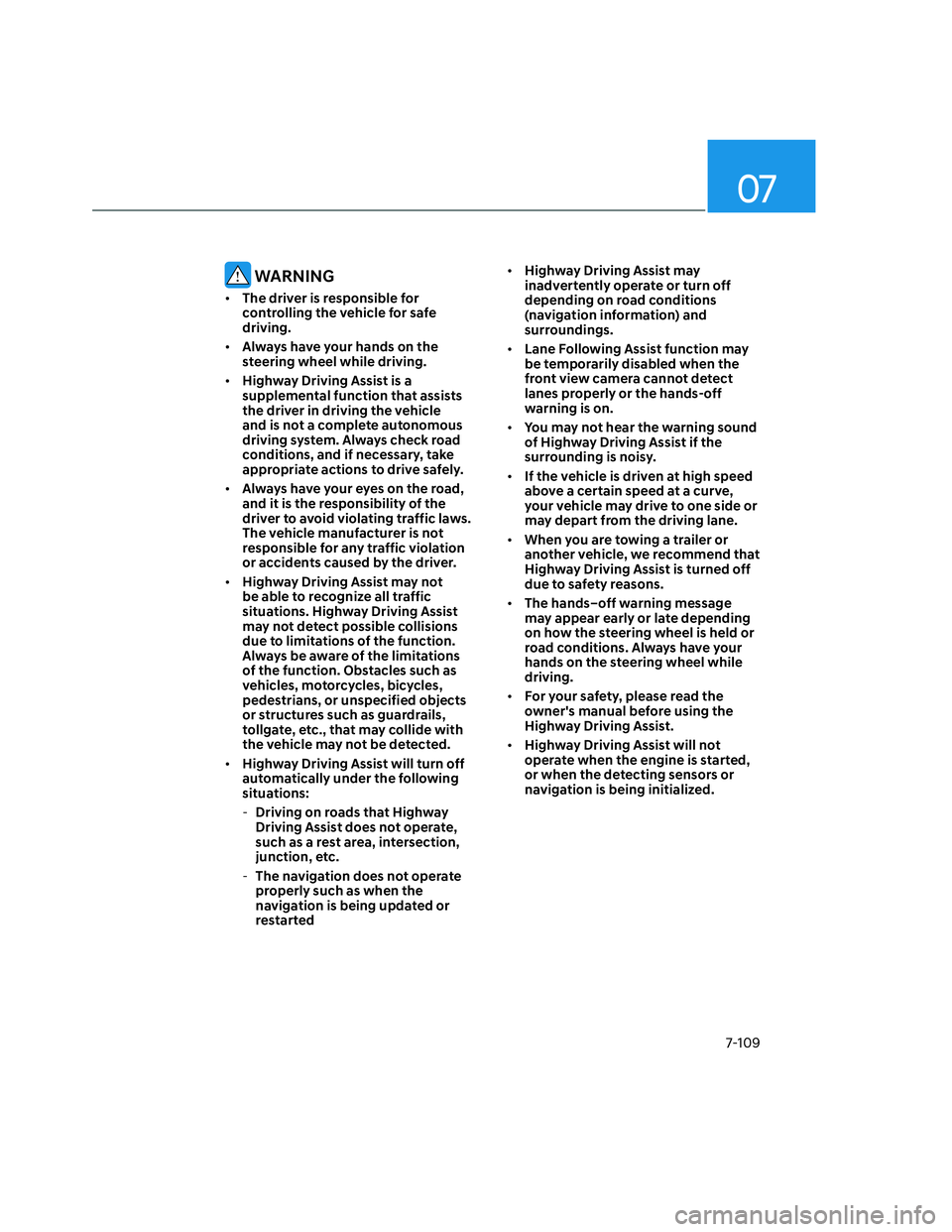
07
7-109
WARNING
• The driver is responsible for
controlling the vehicle for safe
driving.
• Always have your hands on the
steering wheel while driving.
• Highway Driving Assist is a
supplemental function that assists
the driver in driving the vehicle
and is not a complete autonomous
driving system. Always check road
conditions, and if necessary, take
appropriate actions to drive safely.
• Always have your eyes on the road,
and it is the responsibility of the
driver to avoid violating traffic laws.
The vehicle manufacturer is not
responsible for any traffic violation
or accidents caused by the driver.
• Highway Driving Assist may not
be able to recognize all traffic
situations. Highway Driving Assist
may not detect possible collisions
due to limitations of the function.
Always be aware of the limitations
of the function. Obstacles such as
vehicles, motorcycles, bicycles,
pedestrians, or unspecified objects
or structures such as guardrails,
tollgate, etc., that may collide with
the vehicle may not be detected.
• Highway Driving Assist will turn off
automatically under the following
situations:
-Driving on roads that Highway
Driving Assist does not operate,
such as a rest area, intersection,
junction, etc.
-The navigation does not operate
properly such as when the
navigation is being updated or
restarted • Highway Driving Assist may
inadvertently operate or turn off
depending on road conditions
(navigation information) and
surroundings.
• Lane Following Assist function may
be temporarily disabled when the
front view camera cannot detect
lanes properly or the hands-off
warning is on.
• You may not hear the warning sound
of Highway Driving Assist if the
surrounding is noisy.
• If the vehicle is driven at high speed
above a certain speed at a curve,
your vehicle may drive to one side or
may depart from the driving lane.
• When you are towing a trailer or
another vehicle, we recommend that
Highway Driving Assist is turned off
due to safety reasons.
• The hands–off warning message
may appear early or late depending
on how the steering wheel is held or
road conditions. Always have your
hands on the steering wheel while
driving.
• For your safety, please read the
owner's manual before using the
Highway Driving Assist.
• Highway Driving Assist will not
operate when the engine is started,
or when the detecting sensors or
navigation is being initialized.
Page 462 of 598
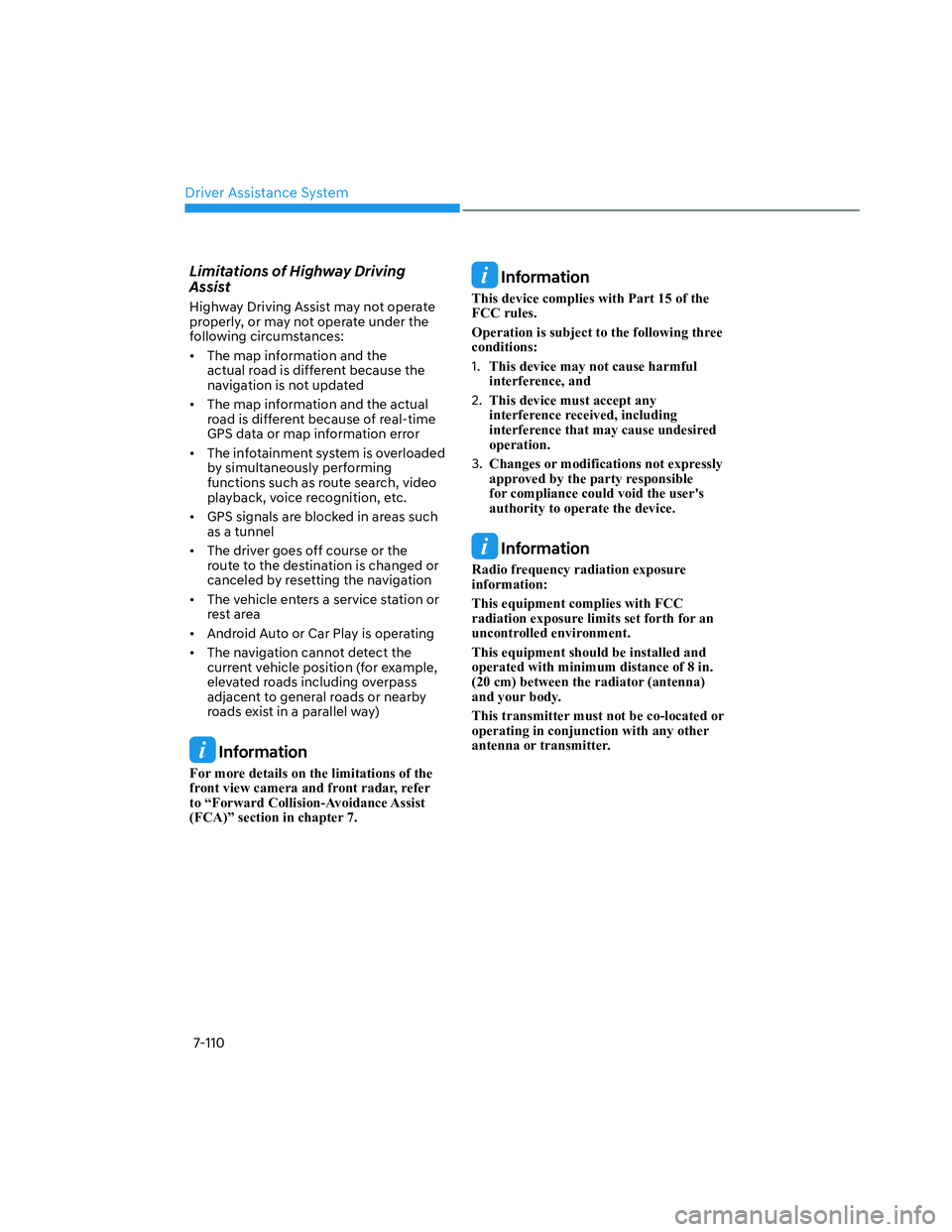
Driver Assistance System
7-110
Limitations of Highway Driving
Assist
Highway Driving Assist may not operate
properly, or may not operate under the
following circumstances:
• The map information and the
actual road is different because the
navigation is not updated
• The map information and the actual
road is different because of real-time
GPS data or map information error
• The infotainment system is overloaded
by simultaneously performing
functions such as route search, video
playback, voice recognition, etc.
• GPS signals are blocked in areas such
as a tunnel
• The driver goes off course or the
route to the destination is changed or
canceled by resetting the navigation
• The vehicle enters a service station or
rest area
• Android Auto or Car Play is operating
• The navigation cannot detect the
current vehicle position (for example,
elevated roads including overpass
adjacent to general roads or nearby
roads exist in a parallel way)
Information
For more details on the limitations of the
front view camera and front radar, refer
to “Forward Collision-Avoidance Assist
(FCA)” section in chapter 7.
Information
This device complies with Part 15 of the
FCC rules.
Operation is subject to the following three
conditions:
1. This device may not cause harmful
interference, and
2. This device must accept any
interference received, including
interference that may cause undesired
operation.
3. Changes or modifications not expressly
approved by the party responsible
for compliance could void the user's
authority to operate the device.
Information
Radio frequency radiation exposure
information:
This equipment complies with FCC
radiation exposure limits set forth for an
uncontrolled environment.
This equipment should be installed and
operated with minimum distance of 8 in.
(20 cm) between the radiator (antenna)
and your body.
This transmitter must not be co-located or
operating in conjunction with any other
antenna or transmitter.
Page 496 of 598
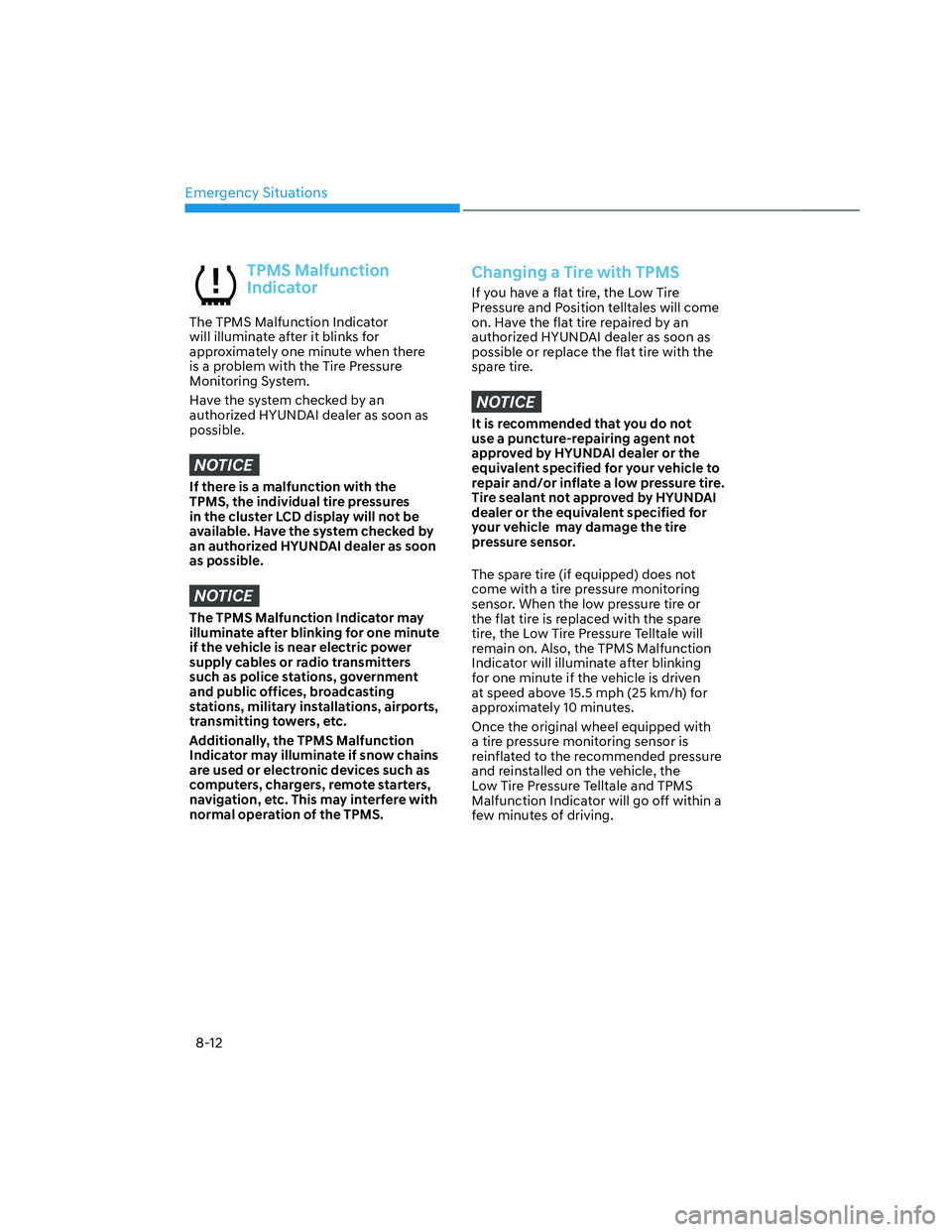
Emergency Situations
8-12
TPMS Malfunction
Indicator
The TPMS Malfunction Indicator
will illuminate after it blinks for
approximately one minute when there
is a problem with the Tire Pressure
Monitoring System.
Have the system checked by an
authorized HYUNDAI dealer as soon as
possible.
NOTICE
If there is a malfunction with the
TPMS, the individual tire pressures
in the cluster LCD display will not be
available. Have the system checked by
an authorized HYUNDAI dealer as soon
as possible.
NOTICE
The TPMS Malfunction Indicator may
illuminate after blinking for one minute
if the vehicle is near electric power
supply cables or radio transmitters
such as police stations, government
and public offices, broadcasting
stations, military installations, airports,
transmitting towers, etc.
Additionally, the TPMS Malfunction
Indicator may illuminate if snow chains
are used or electronic devices such as
computers, chargers, remote starters,
navigation, etc. This may interfere with
normal operation of the TPMS.
Changing a Tire with TPMS
If you have a flat tire, the Low Tire
Pressure and Position telltales will come
on. Have the flat tire repaired by an
authorized HYUNDAI dealer as soon as
possible or replace the flat tire with the
spare tire.
NOTICE
It is recommended that you do not
use a puncture-repairing agent not
approved by HYUNDAI dealer or the
equivalent specified for your vehicle to
repair and/or inflate a low pressure tire.
Tire sealant not approved by HYUNDAI
dealer or the equivalent specified for
your vehicle may damage the tire
pressure sensor.
The spare tire (if equipped) does not
come with a tire pressure monitoring
sensor. When the low pressure tire or
the flat tire is replaced with the spare
tire, the Low Tire Pressure Telltale will
remain on. Also, the TPMS Malfunction
Indicator will illuminate after blinking
for one minute if the vehicle is driven
at speed above 15.5 mph (25 km/h) for
approximately 10 minutes.
Once the original wheel equipped with
a tire pressure monitoring sensor is
reinflated to the recommended pressure
and reinstalled on the vehicle, the
Low Tire Pressure Telltale and TPMS
Malfunction Indicator will go off within a
few minutes of driving.
Page 560 of 598
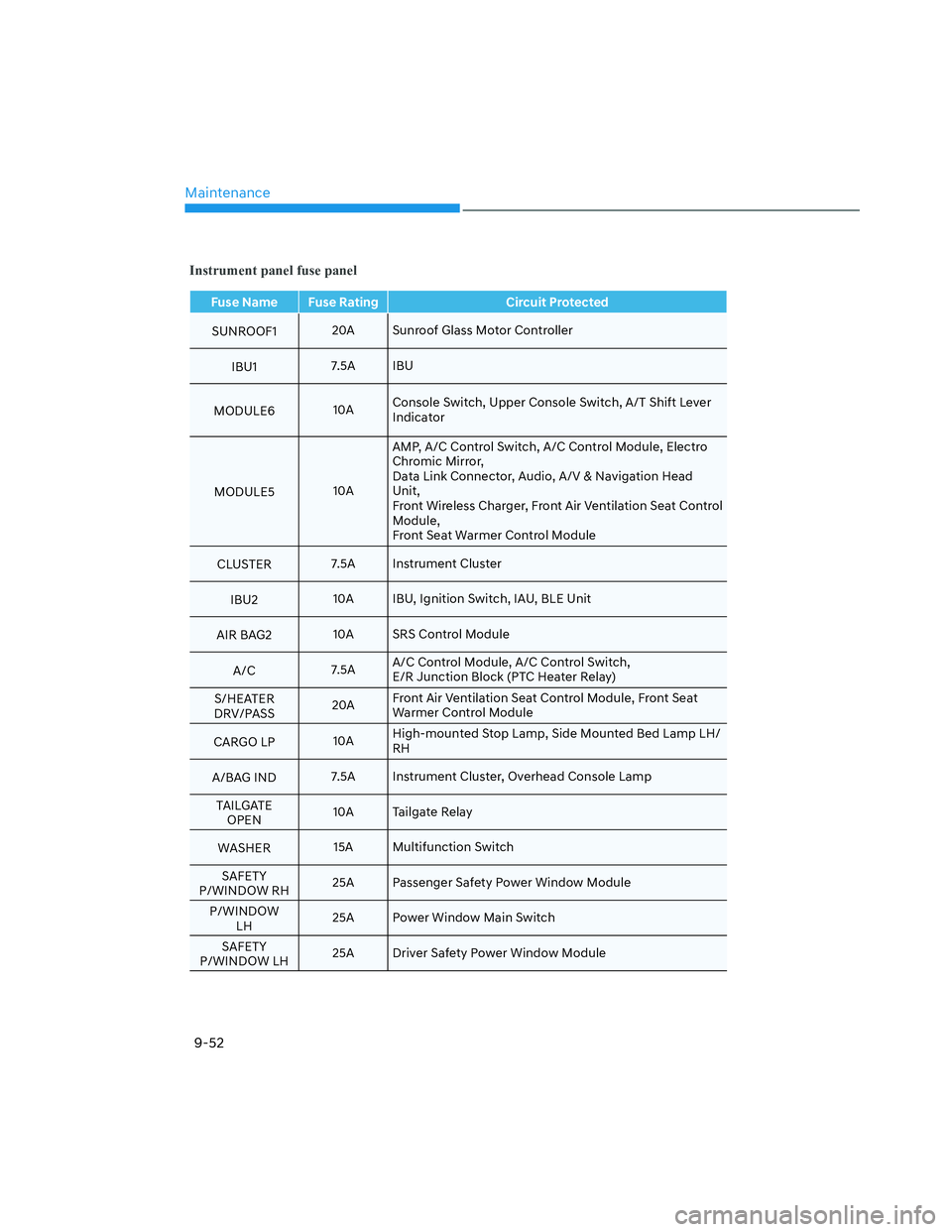
Maintenance
9-52
Instrument panel fuse panel
Fuse Name Fuse Rating Circuit Protected
SUNROOF120A Sunroof Glass Motor Controller
IBU17.5A IBU
MODULE610AConsole Switch, Upper Console Switch, A/T Shift Lever
Indicator
MODULE510AAMP, A/C Control Switch, A/C Control Module, Electro
Chromic Mirror,
Data Link Connector, Audio, A/V & Navigation Head
Unit,
Front Wireless Charger, Front Air Ventilation Seat Control
Module,
Front Seat Warmer Control Module
CLUSTER7.5A Instrument Cluster
IBU210A IBU, Ignition Switch, IAU, BLE Unit
AIR BAG210A SRS Control Module
A/C7.5AA/C Control Module, A/C Control Switch,
E/R Junction Block (PTC Heater Relay)
S/HEATER
DRV/PASS20AFront Air Ventilation Seat Control Module, Front Seat
Warmer Control Module
CARGO LP10AHigh-mounted Stop Lamp, Side Mounted Bed Lamp LH/
RH
A/BAG IND7.5A Instrument Cluster, Overhead Console Lamp
TAILGATE
OPEN10A Tailgate Relay
WASHER15A Multifunction Switch
SAFETY
P/WINDOW RH25A Passenger Safety Power Window Module
P/WINDOW
LH25A Power Window Main Switch
SAFETY
P/WINDOW LH25A Driver Safety Power Window Module
Page 561 of 598
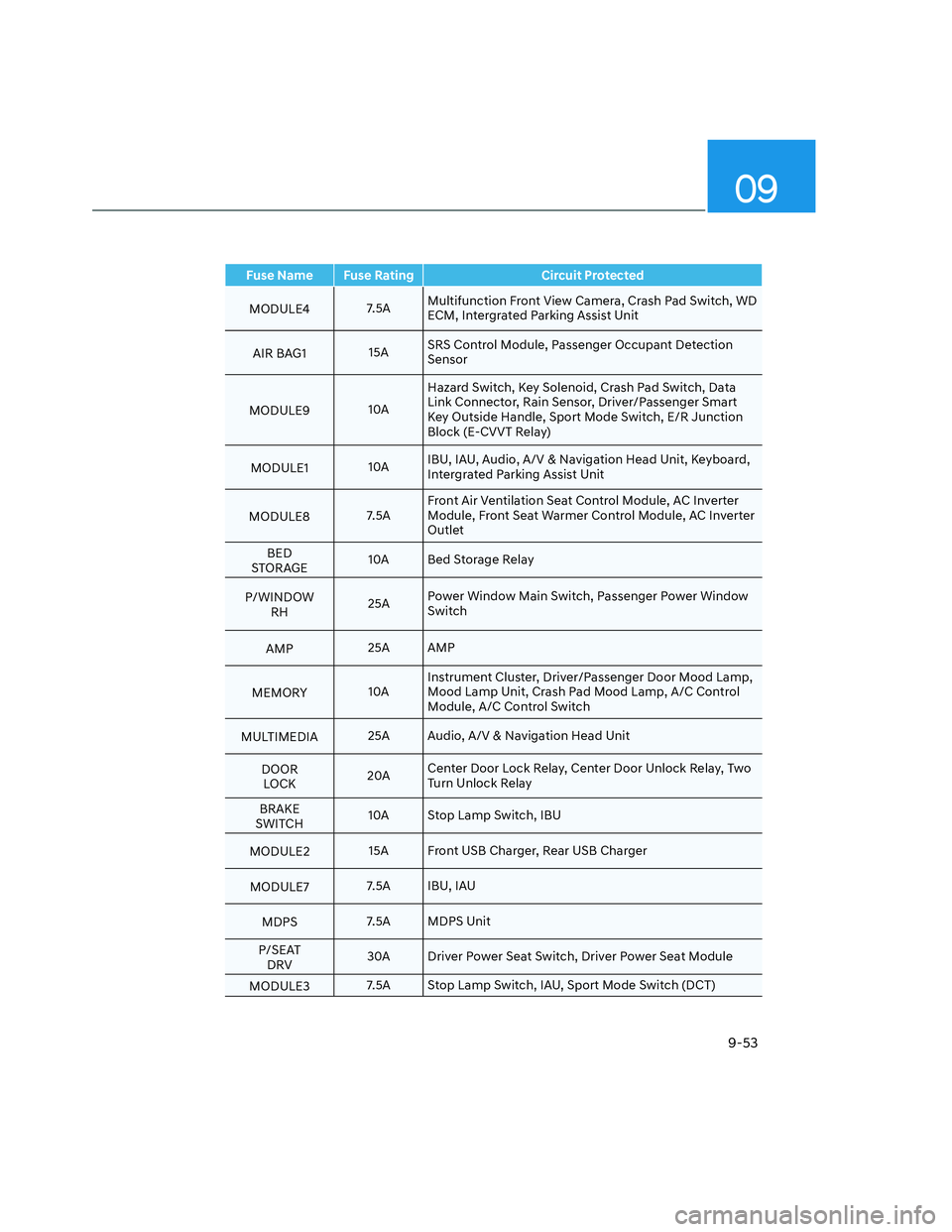
09
9-53
Fuse Name Fuse Rating Circuit Protected
MODULE47.5AMultifunction Front View Camera, Crash Pad Switch, WD
ECM, Intergrated Parking Assist Unit
AIR BAG115ASRS Control Module, Passenger Occupant Detection
Sensor
MODULE910AHazard Switch, Key Solenoid, Crash Pad Switch, Data
Link Connector, Rain Sensor, Driver/Passenger Smart
Key Outside Handle, Sport Mode Switch, E/R Junction
Block (E-CVVT Relay)
MODULE110AIBU, IAU, Audio, A/V & Navigation Head Unit, Keyboard,
Intergrated Parking Assist Unit
MODULE87.5AFront Air Ventilation Seat Control Module, AC Inverter
Module, Front Seat Warmer Control Module, AC Inverter
Outlet
BED
STORAGE10A Bed Storage Relay
P/WINDOW
RH25APower Window Main Switch, Passenger Power Window
Switch
AMP25A AMP
MEMORY10AInstrument Cluster, Driver/Passenger Door Mood Lamp,
Mood Lamp Unit, Crash Pad Mood Lamp, A/C Control
Module, A/C Control Switch
MULTIMEDIA25A Audio, A/V & Navigation Head Unit
DOOR
LOCK20ACenter Door Lock Relay, Center Door Unlock Relay, Two
Turn Unlock Relay
BRAKE
SWITCH10A Stop Lamp Switch, IBU
MODULE215A Front USB Charger, Rear USB Charger
MODULE77.5A IBU, IAU
MDPS7.5A MDPS Unit
P/SEAT
DRV30A Driver Power Seat Switch, Driver Power Seat Module
MODULE37.5A Stop Lamp Switch, IAU, Sport Mode Switch (DCT)
Page 593 of 598

I
I-9
M
Maintenance Services ............................................................................................ 9-4
Owner Maintenance Precautions........................................................................ 9-4
Owner’s Responsibility ...................................................................................... 9-4
Manual Climate Control System ......................................................................... 5-85
Heating and Air Conditioning .......................................................................... 5-86
System Maintenance ........................................................................................ 5-91
System Operation ............................................................................................. 5-90
Manual Speed Limit Assist (MSLA) .................................................................. 7-56
Manual Speed Limit Assist Operation ............................................................ 7-56
Mirrors ................................................................................................................. 5-42
Inside Rearview Mirror .................................................................................... 5-42
Side View Mirrors ............................................................................................ 5-52
N
Navigation-Based Smart Cruise Control (NSCC) .............................................. 7-93
Limitations of Navigation-based Smart Cruise Control .................................. 7-96
Navigation-based Smart Cruise Control Operation ......................................... 7-94
Navigation-based Smart Cruise Control Settings............................................. 7-94
O
Owner Maintenance............................................................................................... 9-5
Owner Maintenance Schedule............................................................................ 9-6
R
Rear Cross-Traffic Collision-Avoidance Assist (RCCA) .................................. 7-120
Rear Cross-Traffic Collision- Avoidance Assist Malfunction and
Limitations ................................................................................................... 7-126
Rear Cross-Traffic Collision- Avoidance Assist Operation............................ 7-122
Rear Cross-Traffic Collision-Avoidance Assist Settings................................ 7-121
Rear Occupant Alert (ROA) ............................................................................... 5-38
Rear Occupant Alert Operation ....................................................................... 5-38
Rear View Monitor (RVM) ............................................................................... 7-111
Rear View Monitor Malfunction and Limitations .......................................... 7-114
Rear View Monitor Operation ........................................................................ 7-112
Rear View Monitor Settings ........................................................................... 7-112